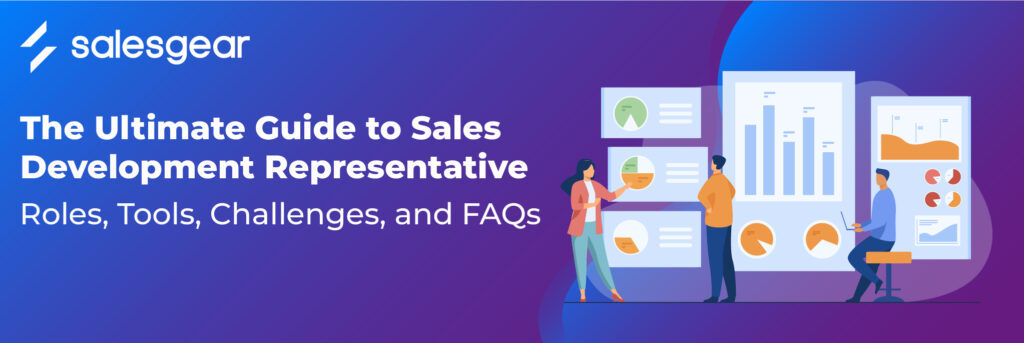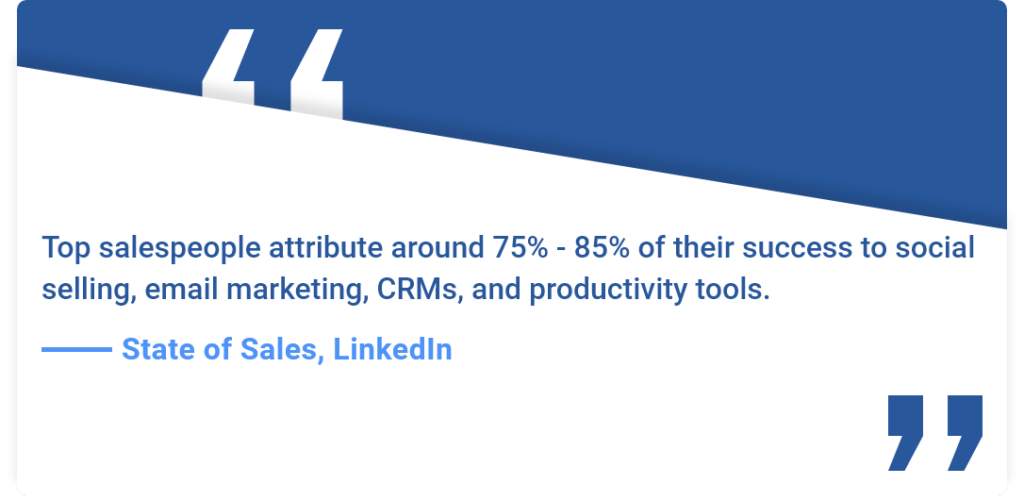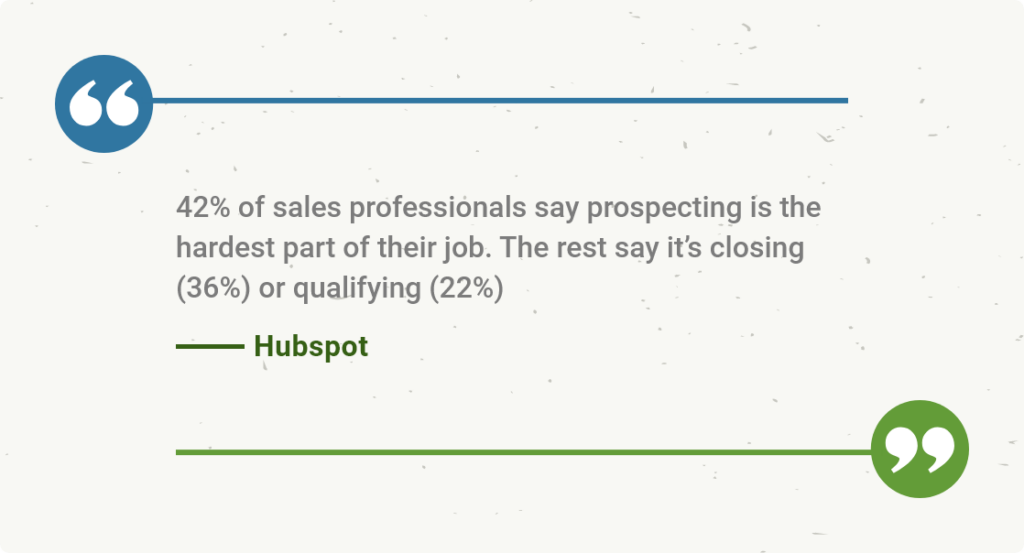
A Sales Development Representative (SDR) is responsible for generating and qualifying leads, which are critical to the success of any sales team. Without SDRs, sales teams would be running blind and they’ll struggle to identify and pursue potential customers. This would ultimately lead to decreased revenue growth for the organization.
In this guide, we will explore everything you need to know about SDRs.
- Role of an SDR in the sales cycle
- A typical day in the life of an SDR
- The essential tools they need to succeed.
- We will examine the differences between inbound and outbound SDRs
- Differences between SDRs and Business Development Representatives (BDRs).
- Common challenges faced by SDRs and how to overcome them.
- Career path for SDRs
- Frequently asked questions about SDRs
Whether you’re a new SDR looking to improve your skills or an aspiring SDR looking to break into the field, this guide will provide you with the knowledge and insights you need to succeed in a sales development role.
Role of an SDR in the sales cycle
The sales cycle is the process by which a sales team identifies, qualifies, and closes deals with potential customers. It typically consists of several stages, including prospecting, lead generation and qualification, and closing.
Where SDRs Fit into the Sales Cycle
SDRs are typically responsible for the first stage of the sales cycle, which is prospecting. Their primary role is to identify and qualify potential customers who may be interested in their organization’s products or services. SDRs use a variety of tools and techniques to find potential customers, including cold calling, email outreach, social media, and targeted advertising.
The primary goal of an SDR is to generate qualified leads for their organization’s sales team. Qualified leads are potential customers who have expressed interest in the organization’s products or services and have met certain criteria, such as having a specific budget, timeline, or need.
The objectives of an SDR include:
- Identifying potential customers who may be interested in the organization’s products or services
- Qualifying leads to ensure that they meet the organization’s criteria for a qualified lead
- Setting up appointments or demos with qualified leads for the sales team to follow up on
- Building relationships with potential customers to keep them engaged and interested in the organization’s offerings
- Collecting feedback from potential customers to improve the organization’s sales and marketing strategies.
Importance of Collaboration between SDRs and other Sales Teams
Collaboration between SDRs and other sales teams, such as account executives (AEs) and sales managers, is crucial for the success of the sales cycle. SDRs rely on other sales teams to help them close deals and convert qualified leads into customers.
In turn, other sales teams rely on SDRs to identify and qualify potential customers who may be interested in their offerings. By working together, sales teams can create a seamless and efficient sales cycle that delivers results for the organization.
Collaboration also helps to ensure that all teams are aligned in their goals and objectives and that there is a consistent message and approach across all stages of the sales cycle.
A day in the life of an SDR
A. Overview of a Typical Day in the Life of an SDR
A typical day in the life of an SDR can be very fast-paced and challenging. Here is an overview of what a typical day might look like for an SDR:
8:00 am – Check emails and follow up on any outstanding leads from the previous day
9:00 am – Make outbound calls to potential customers
10:00 am – Follow up on any inbound leads that have come in
11:00 am – Attend a team meeting to discuss progress and strategy
12:00 pm – Take a lunch break
1:00 pm – Continue making outbound calls
2:00 pm – Follow up on any leads that have shown interest in the organization’s offerings
3:00 pm – Enter data into the organization’s CRM system
4:00 pm – Wrap up any loose ends and prepare for the next day
Key Responsibilities and Tasks of an SDR
The key responsibilities and tasks of an SDR include:
- Prospecting: SDRs are responsible for identifying and qualifying potential customers who may be interested in their organization’s products or services. This typically involves cold calling, email outreach, social media, and targeted advertising.
- Lead Qualification: Once potential customers have been identified, SDRs need to qualify them to ensure that they meet the organization’s criteria for a qualified lead. This involves asking questions to determine the customer’s needs, budget, timeline, and decision-making process.
- Booking Meetings: SDRs are responsible for booking meetings or demos with qualified leads for the sales team to follow up on.
- Relationship Building: SDRs need to build relationships with potential customers to keep them engaged and interested in the organization’s offerings.
- Data Entry: SDRs need to enter data into the organization’s CRM system to keep track of leads and customer interactions.
Time Management Tips for SDRs
Effective time management is crucial for SDRs to be successful in their role. Here are some time management tips for SDRs:
- Prioritize Tasks: Make a list of tasks that need to be completed each day and prioritize them based on urgency and importance.
- Schedule Breaks: Take breaks throughout the day to avoid burnout and maintain focus.
- Set Goals: Set daily, weekly, and monthly goals to stay motivated and focused.
- Use Tools and Automation: Use tools and automation to streamline tasks and save time.
- Stay Organized: Keep your workspace and CRM system organized to avoid wasting time looking for information.
Tools that an SDR needs
To be successful in their role, SDRs need access to a variety of tools and technologies. Here is an overview of some of the essential tools that an SDR needs.
- CRM System: A Customer Relationship Management (CRM) system is a software platform that enables organizations to manage their interactions with customers and potential customers. SDRs use CRM systems to track leads, manage customer data, and analyze sales performance.
- Email Marketing Platform: An email marketing platform allows SDRs to send targeted email campaigns to potential customers. These campaigns can include personalized messages, product information, and calls-to-action (CTAs).
- Sales Engagement Platform: A sales engagement platform helps SDRs automate their sales outreach and follow-up tasks. These platforms typically include features such as email tracking, appointment scheduling, and sales sequence automation.
- Social Media Management Tool: A social media management tool enables SDRs to manage their social media accounts and track social media engagement. These tools can also help SDRs monitor social media conversations and identify potential leads.
- Sales Intelligence Tool: A sales intelligence tool helps SDRs gather insights and data on potential customers. These tools can provide information on a customer’s industry, competitors, and buying behavior.
Extra resource– Top 8 Outbound Sales Tools You Need [With the 3 Best Techniques]

Lead Generation Tools and Techniques
Lead generation is a crucial part of the SDR role, and there are several tools and techniques that SDRs can use to generate leads. Some of the most effective lead-generation tools and techniques include:
- Sales Navigator: LinkedIn’s Sales Navigator is a powerful tool for lead generation. It enables SDRs to search for potential customers based on criteria such as industry, job title, and company size.
- Email Outreach: SDRs can use email outreach to reach out to potential customers and introduce them to their organization’s products or services.
- Social Media: Social media platforms such as LinkedIn and Twitter can be effective tools for lead generation. SDRs can use these platforms to engage with potential customers and build relationships.
- Referrals: Referrals from existing customers and business partners can be a valuable source of new leads for SDRs.
By using these lead generation tools and techniques, SDRs can generate a steady stream of qualified leads for their organization.
Check out the Top 10 SDR Tools to Boost Your Productivity
Inbound vs Outbound SDR
Inbound SDRs are responsible for handling leads that come to the organization through inbound channels such as the company website, social media, or other marketing campaigns.
Outbound SDRs, on the other hand, are responsible for proactively reaching out to potential customers through cold calls, emails, and other outreach methods.
| Inbound SDR | Outbound SDR |
| Handles leads that come to the organization through inbound channels | Proactively reaches out to potential customers through cold calls, emails, and other outreach methods |
| Qualifies leads and passes them on to the appropriate sales representative | Identifies potential customers and introduces them to the organization’s products or services |
| Higher predictable workload | Mostly, unpredictable workload |
| More opportunities to learn about the firms’ products. | Less time to learn about the organization’s products. |
| Less control over the quality of the leads received | More control over the quality of leads pursued |
| Higher volume of leads to manage | More rejection and resistance from potential customers. |
| Less flexibility in outreach methods | More flexibility in outreach methods |
When deciding which role is right for you, consider your skills, interests, and personality traits. If you enjoy working with a steady stream of leads and learning about the organization’s products and services, an inbound SDR role may be a good fit.
On the other hand, if you are comfortable with uncertainty and enjoy the challenge of identifying and pursuing new leads, an outbound SDR role may be more suitable.
Suggested Read: The Yin and Yang of B2B Sales: Outbound SDR and Inbound SDR
BDR vs SDR
| Points | SDR | BDR |
| Focus | The high volume of leads | A smaller number of high-value accounts |
| Activities | Qualifying leads and passing them on to the appropriate sales rep. | Higher-level prospecting and lead-generation activities |
| Sales cycle | Shorter due to smaller deal sizes | Longer due to higher-value deals |
| Potential no of customers | Larger pool | Smaller pool |
| Rejection and Resistance | More rejection and resistance from potential customers | Less rejection and resistance from potential customers |
| Workload | More unpredictable due to a higher volume of leads | More predictable due to the smaller number of high-value accounts |
| Advancement Opportunities | May not offer as many opportunities for advancement within the organization | May offer more opportunities for advancement into higher-level sales roles |
Extra resource: SDR vs BDR: Differences Between the Two Roles
Challenges faced by a Sales Development Representative
- Prospecting challenges- One of the biggest challenges for SDRs is dealing with rejection from potential customers while prospecting. It can be difficult to hear “no” repeatedly, especially when SDRs are evaluated based on their ability to generate leads and set appointments.
- Time management challenges- SDRs are often required to juggle multiple tasks, including prospecting, qualifying leads, and scheduling appointments. Managing their time effectively is critical to meeting their goals.
- Technical challenges- The tools and technology used by SDRs are constantly evolving, and it can be challenging to keep up with the latest trends and features.
- Collaborative challenges- A lack of proper alignment between different teams, especially sales, and marketing comes with its own set of challenges.

How to overcome these challenges:
- Prospecting: SDRs can overcome the challenge of rejection by developing a positive mindset and focusing on the successes they achieve, rather than dwelling on the rejections. Role-playing and practicing objection-handling techniques can also help build confidence and reduce the impact of rejection.
- Time Management: Effective time management is essential for SDRs to be successful. They can overcome this challenge by prioritizing their tasks, minimizing distractions, and utilizing tools like calendars and to-do lists.
- Sales Tools and Technology: SDRs can overcome this challenge by staying up to date on the latest sales tools and technology. They can do this by attending webinars, workshops, and conferences, and by seeking out training and development opportunities from their organization.
- Training and Development: SDRs can overcome the challenge of limited training and development by seeking out resources like online courses, mentorship programs, and coaching from more experienced sales professionals within their organization.
By recognizing these common challenges and proactively working to overcome them, SDRs can increase their effectiveness and achieve success in their role.
Suggested Read: The Sales Challenge Survival Guide for SDRs
SDR career path
Sales Development Representatives typically begin their careers with entry-level positions in sales teams. With time and experience, they can progress through the ranks to become sales managers, account executives, or even directors of sales.
Advancement Opportunities for SDRs
The career advancement opportunities for SDRs depend on their performance and the size and structure of the company they work for.
Some possible advancement opportunities for SDRs include:
- Promotion to a senior SDR position, with additional responsibilities and a higher base salary
- Promotion to an account executive (AE) or sales manager role, where they oversee a team of SDRs
- Further ahead as a VP of Sales or a CRO (Chief Revenue Officer)
How to Succeed and Advance in an SDR Role
To succeed and advance in an SDR role, it is essential to focus on building the necessary skills and consistently achieving or exceeding targets. Here are some tips:
- Develop strong communication and interpersonal skills to engage effectively with potential customers
- Stay up to date on the latest sales techniques and tools, and leverage them to enhance your productivity and results
- Collaborate effectively with other teams, such as marketing and sales, to ensure alignment and maximize outcomes
- Seek out and implement feedback from your manager and peers to improve your performance continuously
FAQs on SDR
What is an SDR in sales?
A Sales Development Representative (SDR) is a professional responsible for generating and qualifying leads for the sales team. They are the initial point of contact for potential customers and work closely with the sales and marketing teams.
What skills do you need as a sales development representative?
Strong communication skills, interpersonal skills, active listening, and problem-solving abilities are essential for an SDR. They must be able to communicate the value of a product or service to potential customers effectively.
What is BDR vs SDR?
See the section on the same topic above.
What Makes a Great Sales Development Rep (SDR)?
- They are meticulous, well-organized, and efficient time managers.
- SDRs are clear about their priorities, so they don’t pounce on every bright idea.
- They will listen intently and ask thoughtful inquiries while being meticulous.
- Leading SDRs are willing to participate in the game.
- SDRs don’t let opinions or other distractions get in the way of their objectives.
- They enjoy their work since it’s enjoyable and friendly.
- They aim to win at all costs because they are naturally competitive.
Is SDR inbound or outbound?
See the section on the same topic above
What are SDR interview questions?
- Questions on how you handle rejection
- What tools have you used in the previous org?
- How did you handle a setback at your previous work?
- In your opinion, what is the most important aspect of an SDR?
- How do you engage a prospect?
- If you don’t hit your quota, how will you react?
What are some of the primary tools that SDRs use?
SDRs use several tools, including customer relationship management (CRM) software, email automation tools, and sales engagement platforms to manage their daily tasks.
What is the difference between an SDR and an account executive?
While an SDR is responsible for generating and qualifying leads, an account executive is responsible for closing deals with qualified leads.
What is the typical career path for an SDR?
SDRs can progress through the ranks to become senior SDRs, account executives, sales managers, or even directors of sales.
Final Thoughts and Recommendations for Aspiring and Current SDRs
If you are an aspiring SDR, focus on building strong communication skills, staying up to date on the latest sales techniques and tools, and collaborating effectively with other teams. If you are a current SDR, seek out feedback from your manager and peers, continuously improve your skills and performance, and explore opportunities for career advancement.
Remember that the SDR role can be a great entry point into a successful sales career, and the skills you develop can be transferable to various other roles in sales and marketing.